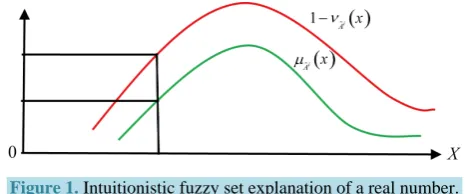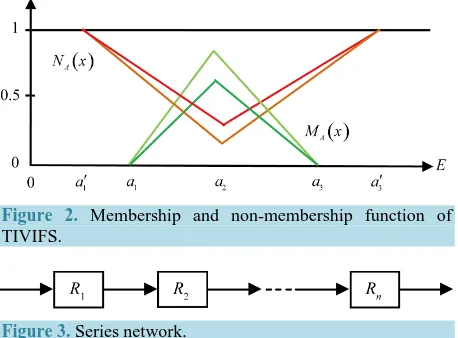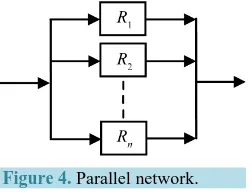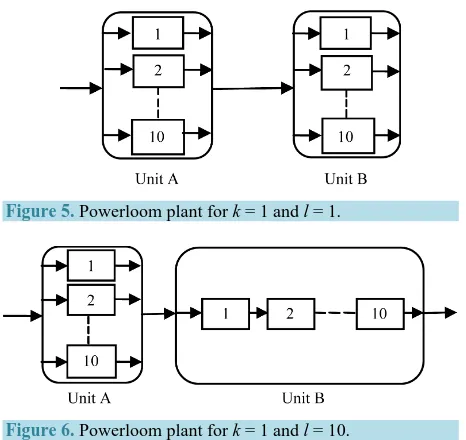http://dx.doi.org/10.4236/am.2014.513193
Reliability Analysis of a Powerloom Plant
Using Interval Valued Intuitionistic
Fuzzy Sets
Sanjay Kumar TyagiGeneral Requirements Department, Ibri College of Applied Sciences, Ministry of Higher Education, Ibri, Sultanate of Oman
Email: sanjay_tyagi94@rediffmail.com
Received 8 April 2014; revised 18 May 2014; accepted 2 June 2014
Copyright © 2014 by author and Scientific Research Publishing Inc.
This work is licensed under the Creative Commons Attribution International License (CC BY).
http://creativecommons.org/licenses/by/4.0/
Abstract
In this paper, we investigate the reliability analysis of a powerloom plant by using interval valued intuitionistic fuzzy sets (IVIFS). Herein, we modeled a powerloom plant as a gracefully degradable system having two units A(n) and B(m) connected in series. The reliability of n components of unit
A and m components of unit B is assumed to be an IVIFS defined over the universe of discourse [0, 1]. Thus, the reliability of the system obtained is an IVIFS that covers the inherited uncertainty in data collection and reliability evaluation of a powerloom plant.
Keywords
Reliability, Interval Valued Intuitionistic Fuzzy Sets, Powerloom Plant, Parallel Redundancy, Graceful Degradation
1. Introduction
ob-an interval values is more realistic. Taking view of that apparently Sambuc [11] introduced interval valued fuzzy sets (IVFS). He called them φ-flou functions. Later, intuitionistic fuzzy set (IFS) was introduced by Atanassov [12] in 1983. IFS provides the opportunity to model hesitation and uncertainty by introducing a non-membership function in addition to membership function. Tyagi and Akram [13] used IFS to evaluate human reliability of a man-machine system. Wu and Mendel [14] made linguistic summarization using IF-THEN rules and interval type-2 fuzzy sets. Beliakov et al. [15] analyzed the median aggregation operator of IFS and IVFS. In 1989, Ata-nassov and Gargov [16] introduced the concept of IVIFS along with several of their properties. Unlike IFS, IVIFS maps the universe of discourse E to the set of intervals over [0, 1].
In our work, we use IVIFS to investigate the reliability evaluation of a powerloom plant. A powerloom plant is a small scale industrial setup that weaves threads of different varieties of colours to produce a long piece of cloth of standard size [17]. In the present model, let A(n) and B(m) be two units having n and m
(
n≥m)
com-ponents respectively in parallel redundancy. Units A(n) carries n threads of different colours through its n-identical parallel components, and after weaving threads of some specified colour combination together pro-vides m threads to unit B(m). Unit B(m) receives these m threads through its m-identical parallel components and weaves them together to produce a long piece of cloth of some standard size. Failure of any component of either unit would result in missing a thread of that unit and deteriorate the quality of that product. Without any loss of generality, we can assume that at the most one component of these units may fail at any point of time. This shows that both the units of the system are gracefully degradable. Further, we may assume that owing to(
1)
k ≤ ≤k n and l
(
1≤ ≤l m)
missing threads in unit A(n) and B(m) respectively, the quality of the product deteriorates beyond the acceptable limits. Therefore, system will be considered failed in view of reliability esti-mation, if k components of unit A(n) and l components of unit B(m) fail. Choice of k and l depends upon the to-lerable limit to be prescribed by quality control.2.
Preliminaries
2.1. Interval Valued Fuzzy Sets
An IVFS A over a basic set E is specified by a function MA:E→INT
(
[ ]
0,1)
, where INT(
[ ]
0,1)
is the set of all intervals within[ ]
0,1 , i.e. for all x∈E, MA( )
x is an interval over[ ]
0,1 .2.2. Intuitionistic Fuzzy Sets
An IFS Ai [12] on X is given by
{
, i( )
, i( )
:}
iA A
A = <x µ x ν x > ∈x X , where µAi
( )
x :X →[ ]
0,1 and( )
:[ ]
0,1i
A x X
ν → such that 0≤µAi
( )
x +νAi( )
x ≤1 for all x∈X .The value µAi
( )
x is a lower bound on the degree of membership of x derived from the evidence for x and( )
i A x
ν is a lower bound on the negation of x derived from the evidence against x. We refer to
( )
1( )
( )
,i i i
A x A x A x x X
π = −µ −ν ∈ as the intuitionistic index of x. It is the hesitancy of x in Ai due to the lack of knowledge for x∈X or otherwise.
When the universe of discourse X is discrete, an IFS i
A can be written as
( )
( )
{
}
1
,1 for all
i i
n i
j j j j
A A
j
A µ x ν x x x X
=
=
∑
− ∈ .
An IFS Ai with continuous universe of discourse X as shown inFigure 1 can be written as
( )
( )
{
i ,1 i}
for alli
j j j j
A A
X
Figure 1. Intuitionistic fuzzy set explanation of a real number.
2.3. Interval Valued Intuitionistic Fuzzy Sets
An IVIFS [16] [18] is an extension of both, the IFS and IVFS. An IVIFS A over a universal set E is defined as an object of the form:
( )
( )
{
, A , A :}
A= x M x N x x∈E ,
where MA
( )
x ⊂[ ]
0,1 and NA( )
x ⊂[ ]
0,1 are intervals and for all x∈E, 0≤supMA( )
x +supNA( )
x ≤1. This definition of IVIFS is analogous to the definition of IFS, where MA:E→INT(
[ ]
0,1)
is the member-ship function and NA:E→INT(
[ ]
0,1)
is non-membership function.2.4. Triangular Interval-Valued Intuitionistic FuzzySets
A triangular interval valued intuitionistic fuzzy sets (TIVIFS) A over the universe E shown inFigure 2 is de-fined as:
(
)
( )
{
1, 2, 3 ; A}
,{
(
1, 2, 3)
; A( )
}
.A= a a a M x a a a′ ′ N x
2.5. Arithmetic Operations on TIVIFS
Here, we introduce some basic arithmetic operations on TIVIFS. For this, let
(
)
( )
{
1, 2, 3 ; A}
,{
(
1, 2, 3)
; A( )
}
A= a a a M x a a a′ ′ N x
and
(
)
( )
{
1, 2, 3 ; B}
,{
(
1, 2, 3)
; B( )
}
B= a a a M x a a a′ ′ N x
are two TIVIFS defined over a universal set E as shown inFigure 2, then following arithmetic operations be-tween A and B can be defined [18].
(
)
(
( )
( )
)
(
( )
( )
)
{
}
(
)
(
( )
( )
)
(
( )
( )
)
{
}
1 1 2 2 3 3
1 1 2 2 3 3
1) , , ; min inf , inf , min sup , sup ,
, , ; max inf , inf , max sup , sup
A B A B
A B A B
A B a b a b a b M x M x M x M x
a b a b a b N x N x N x N x
⊕ = + + +
′+ ′ + ′+ ′
(
)
(
( )
( )
)
(
( )
( )
)
{
}
(
)
(
( )
( )
)
(
( )
( )
)
{
}
1 1 2 2 3 3
1 1 2 2 3 3
2) , , ; min inf , inf , min sup , sup ,
, , ; max inf , inf , max sup , sup
A B A B
A B A B
A B a b a b a b M x M x M x M x
a b a b a b N x N x N x N x
⊗ =
′ ′ ′ ′
3) a) If k > 0, then, kA=
{
(
ka ka ka1, 2, 3)
;MA( )
x}
,{
(
ka ka ka1′, 2, 3′)
;NA( )
x}
b) If k < 0, then, kA=
{
(
ka ka ka3, 2, 1)
;MA( )
x}
,{
(
ka ka ka3′, 2, 1′)
;NA( )
x}
3. Reliability Analysis of a Series and Parallel Network
3.1. Series Network
Figure 2. Membership and non-membership function of TIVIFS.
Figure 3. Series network.
series network would be given as:
( )
( )
( )
(
)
( )
( )
( )
(
)
}
( )
( )
( )
(
)
(
( )
( )
( )
)
11 2 3 1 2
1 1 1
1 2 1 2 3
1 1 1
1 2 1 2
, , ; min inf , inf , , inf ,
min sup , sup , , sup , , , ;
max inf , inf , , , max sup , sup , , sup
n
S j j
n n n
j j j n
j j j
n n n
n j j j
j j j
n n
R R
a a a M x M x M x
M x M x M x a a a
N x N x N x N x N x N x
= = = = = = = = ⊗ = ′ ′
∏ ∏
∏
∏ ∏
∏
(1)3.2. Parallel Network
Let, Rj =
{
(
a1j,a2j,a3j)
;Mj( )
x}
,{
(
a1′j,a2j,a3′j)
;Nj( )
x}
, j=1, 2,,n be n different IVIFS representing the reliability of n different components of a parallel network as shown inFigure 4, then the reliability RP of this parallel network can be given as:(
)
(
) (
) (
)
(
( )
( )
( )
)
( )
( )
( )
(
)
}
(
) (
) (
)
( )
( )
( )
(
)
( )
11 2 3 1 2
1 1 1
1 2 1 2 3
1 1 1
1 2 1
1 1
1 1 , 1 , 1 ; min inf , inf , , inf ,
min sup , sup , , sup , 1 , 1 , 1 ;
max inf , inf , , , max sup , sup
n
P j
j
n n n
j j j n
j j j
n n n
n j j j
j j j
n
R R
a a a M x M x M x
M x M x M x a a a
N x N x N x N x N
= = = = = = = = − − = − − − − − ′ − − ′
∏
∏
∏
∏
∏
∏
∏
(
2( )
x , , supNn( )
x)
(2)
4. Reliability Analysis of a Powerloom Plant
As mentioned earlier, failure of any component of unit A(n) or B(m) results in missing a thread in either unit and causes the deterioration in the quality of the product. Herein, we considered that both the units in powerloom are gracefully degradable. Further, we may assume that if, k
(
1≤ ≤k n)
threads of unit A(n) and l(
1≤ ≤l m)
threads of unit B(m) are missing, the quality of product deteriorates beyond the acceptable limit. In other words, we can say that the system is considered failed if k-components of unit A(n) and l-components of unit B(m) fail.
Now, let, 1 , 2, ,
A A A
n
R R R be the reliability of n identical components of unit A and 1, 2, ,
B B B
m
Figure 4. Parallel network.
Also, let Rk n/ and Rl m/ represents the probability that at least k-components of unit A and l-components of unit B are working.
On substituting Rk n/ and Rl m/ in (3) for different values of k and l, and the following equation, we obtain the reliability of the powerloom plant.
/ /
A B
k n l m
R=R ⊗R (3)
The choice for the value of k and l components depends upon the tolerable limit prescribed by the quality control department. For numerical estimation of reliability of powerloom plant, we consider that both the units A(n) and B(m) have 10 components each, i.e. n = m = 10.
Since all 10 components of unit A(n) are identical, it may be assumed that they have equal probability of suc-cess (reliability) i.e. 1 2 10
A A A
R =R ==R . In a similar manner we can assume that all components of unit B(m) are having equal reliability i.e. 1 2 10
B B B
R =R ==R . In our work, we assigned TIVIFS to the reliability of each component of both the units as given below.
(
)
[
]
{
}
{
(
)
[
]
}
1 0.19, 0.40, 0.61 : 0.40, 0.66 ; 0.16, 0.43, 0.64 : 0.15, 0.32 2 10
A A A
R = =R ==R
(
)
[
]
{
}
{
(
)
[
]
}
1 0.17, 0.45, 0.64 : 0.38, 0.63 ; 0.14, 0.45, 0.67 : 0.12, 0.31 2 10
B B B
R = =R ==R
We consider the following cases for different values of k and l.
Case I: k = 1, l = 1 represents the system in which at least one component of both the units is required to be working for the smooth functioning of the powerloom plant. In other word, we can say that all components of unit A as well as of unit B are connected in parallel as shown inFigure 5.
Using TIVIFS assigned to the reliability of each component and (2), we evaluate the reliability 1/10 A R and
1/10 B
R of unit A and B respectively.
(
)
[
]
{
}
{
(
)
[
]
}
1/10 0.8784, 0.9939, 0.9999 : 0.4, 0.66 ; 0.8251, 0.9939, 0.9999 : 0.15, 0.32 A
R =
(
)
[
]
{
}
{
(
)
[
]
}
1/10 0.8448, 0.9975, 0.9999 : 0.38, 0.63 ; 0.7787, 0.9975, 0.9999 : 0.12, 0.31 B
R =
On substituting the values of 1 10 A
R and 1 10 B
R in (3), we obtain the reliability R of the powerloom plant as follows.
(
)
[
]
{
0.7421, 0.9914, 0.9998 : 0.38, 0.63 ; 0.6425, 0.9914, 0.9999 : 0.15, 0.32}
{
(
)
[
]
}
R=Case II: k = 1 and l = 10 represents the system, where all components of unit A are connected in parallel and that of unit B are connected in series as shown inFigure 6.
We substitute TIVIFS assigned to the reliability of each component, in (1) and (2) to obtain the reliability
1/10 A
R and 10/10 B
R respectively.
(
)
[
]
{
}
{
(
)
[
]
}
1/10 0.8784, 0.9939, 0.9999 : 0.4, 0.66 ; 0.8251, 0.9939, 0.9999 : 0.15, 0.32 A
R =
(
)
[
]
{
}
{
(
)
[
]
}
10/10 0, 0.0003, 0.0115 : 0.38, 0.63 ; 0, 0.0003, 0.0182 : 0.12, 0.31 B
R =
Further, we substitute the values of 1/10 A
R and 10/10 B
R in (3) and obtain the reliability R of the powerloom plant as follows.
(
)
[
]
{
0, 0.0003, 0.0115 : 0.38, 0.65 ;}
{
(
0, 0.0003, 0.0182 : 0.12, 0.31)
[
]
}
Figure 5. Powerloom plant for k = 1and l = 1.
Figure 6. Powerloom plant for k = 1 and l = 10.
Case III: k = 10 and l = 1 represents the system in which all components of unit A should be working to keep unit A functioning i.e. all components of unit A are connected in series. In a similar manner, the unit B will be functioning if at least one component of unit B is working i.e. all components of unit B are connected in parallel as shown inFigure 7.
(
)
[
]
{
}
{
(
)
[
]
}
10/10 0, 0.0001, 0.0071 : 0.4, 0.66 ; 0, 0.0001, 0.0115 : 0.15, 0.32 A
R =
(
)
[
]
{
}
{
(
)
[
]
}
1/10 0.8448, 0.9975, 0.9999 : 0.38, 0.63 ; 0.7787, 0.9975, 0.9999 : 0.12, 0.31 B
R =
On substituting the values of 10/10 A
R and 1/10 B
R in (3), we obtain the reliability R of powerloom plant.
(
)
[
]
{
0, 0.0001, 0.0071 : 0.38, 0.63 ;}
{
(
0, 0.0001, 0.0115 : 0.12, 0.31)
[
]
}
R=Case IV: k = 10 and l = 10 represents the system in which all components of each unit should be working i.e. all components of both the units are connected in series as shown below inFigure 8.
We substitute TIVIFS assigned to the reliability of each component in (1) to obtain the reliability 10/10 A R and
10/10 B
R of the unit A and unit B respectively.
(
)
[
]
{
}
{
(
)
[
]
}
10/10 0, 0.0001, 0.0071 : 0.4, 0.66 ; 0, 0.0001, 0.0115 : 0.15, 0.32 A
R =
(
)
[
]
{
}
{
(
)
[
]
}
10/10 0, 0.0003, 0.0115 : 0.38, 0.63 ; 0, 0.0003, 0.0182 : 0.12, 0.31 B
R =
Further, we substitute the values of 10/10 A
R and 10/10 B
R in (3) and obtain the reliability R of the powerloom plant as follows:
(
)
[
]
{
0, 0, 0.0001 : 0.38, 0.63 ; 0, 0, 0.0002 : 0.12, 0.31}
{
(
)
[
]
}
R=
5. Conclusion
Figure 7. Powerloom plant for k = 10 and l = 1.
Figure 8. Powerloom plant for k = 10 and l = 10.
for different values of k and l and obtained the reliability of powerloom. The reliability of powerloom plant re-sults as an IVIFS in each case. Obviously, IVIFS are most generalized form of fuzzy sets. Thus, the new ap-proach using IVIFS provides comprehensive results and rules out under/over estimation of reliability of the po-werloom plant.
Acknowledgements
The author would like to extend his heartfelt gratitude to the editor and anonymous reviewers for their critical evaluation and constructive suggestions.
References
[1] Cai, K.Y. (1996) Introduction to Fuzzy Reliability. Kluwer Academic Publishers, Boston.
http://dx.doi.org/10.1007/978-1-4613-1403-5
[2] Zadeh, L.A. (1965) Fuzzy Sets. Information Control, 8, 338-353.
http://dx.doi.org/10.1016/S0019-9958(65)90241-X
[3] Cai, K.Y. and Wen, C.Y. (1990) Street Lighting Lamp Replacement: A Fuzzy Viewpoint. Fuzzy Sets and Systems, 37, 161-172. http://dx.doi.org/10.1016/0165-0114(90)90039-9
[4] Singer, D. (1990) A fuzzy set approach to fault tree and reliability analysis. Fuzzy Sets and Systems, 34, 145-155.
http://dx.doi.org/10.1016/0165-0114(90)90154-X
[5] Chen, S.M. (1994) Fuzzy System Reliability Analysis Using Fuzzy Number Arithmetic Operations. Fuzzy Set and Sys-tems, 64, 31-38.http://dx.doi.org/10.1016/0165-0114(94)90004-3
[6] Bowles, J.B. and Palaez, C.E. (1995) Application of Fuzzy Logic to Reliability Engineering. Proceedings of the IEEE,
83, 435-449.http://dx.doi.org/10.1109/5.364489
[7] Pandey, D. and Tyagi, S.K. (2007) Profust Reliability of a Gracefully Degradable System. Fuzzy Sets and Systems, 158, 794-803.http://dx.doi.org/10.1016/j.fss.2006.10.022
[8] Goguen, J.A. (1967) L-Fuzzy Sets. Journal of Mathematical Analysis and Applications, 18, 145-174.
http://dx.doi.org/10.1016/0022-247X(67)90189-8
[9] Ramer, A. and Wang, C. (1996) Fuzzy Multisets. Proceedings of 1996 Asian Fuzzy System Symposium, Taiwan, 11-14 December 1996, 429-434.
[10] Gehrke, M., Walker, C. and Walker, E. (1996) Some Comments on Interval Valued Fuzzy Sets. International Journal of Intelligent Systems, 11, 751-759.
http://dx.doi.org/10.1002/(SICI)1098-111X(199610)11:10<751::AID-INT3>3.3.CO;2-N
[11] Sambuc, R. (1975) Fonctions φ-floues: Application a l'aide au diagnostic en pathologie thyroidienne. Ph.D. Thesis, University of Marseille, France.
[12] Atanassov, K.T. (1986) Intuitionistic Fuzzy Sets. Fuzzy Sets and Systems, 20, 87-96.
[16] Atanassov, K. and Gargov, G. (1989) Interval-Valued Fuzzy Set. Fuzzy Sets and Systems, 31, 343-349.
http://dx.doi.org/10.1016/0165-0114(89)90205-4
[17] Pandey, D., Jacob, M. and Yadav, J. (1996) Reliability Analysis of a Powerloom Plant with Cold Standby for Its Stra-tegic Unit. Microelectronics Reliability, 36, 115-119.http://dx.doi.org/10.1016/0026-2714(95)00013-R
currently publishing more than 200 open access, online, peer-reviewed journals covering a wide range of academic disciplines. SCIRP serves the worldwide academic communities and contributes to the progress and application of science with its publication.
Other selected journals from SCIRP are listed as below. Submit your manuscript to us via either




